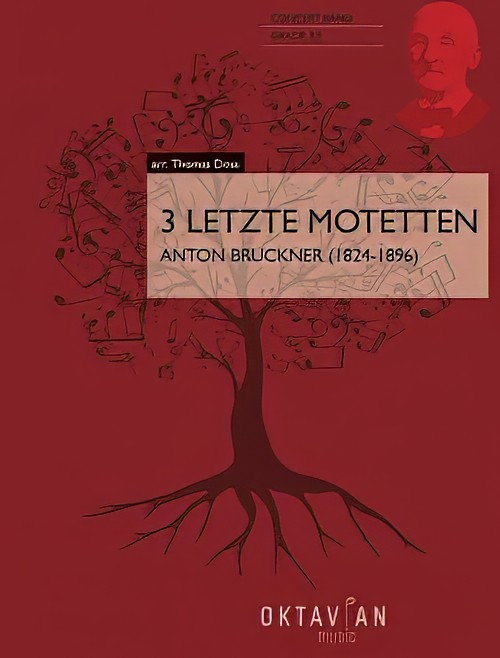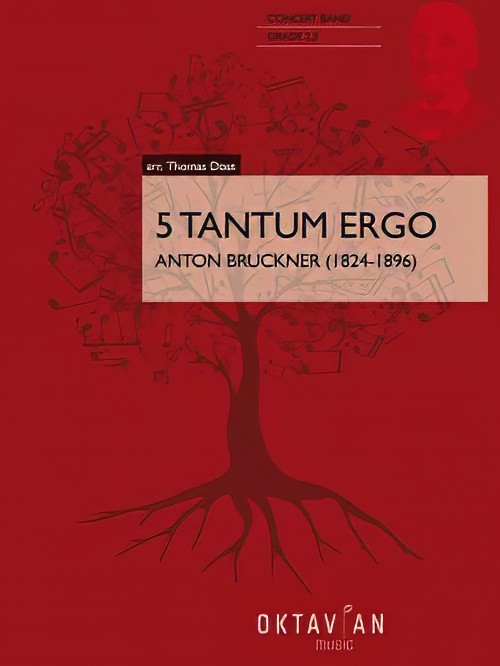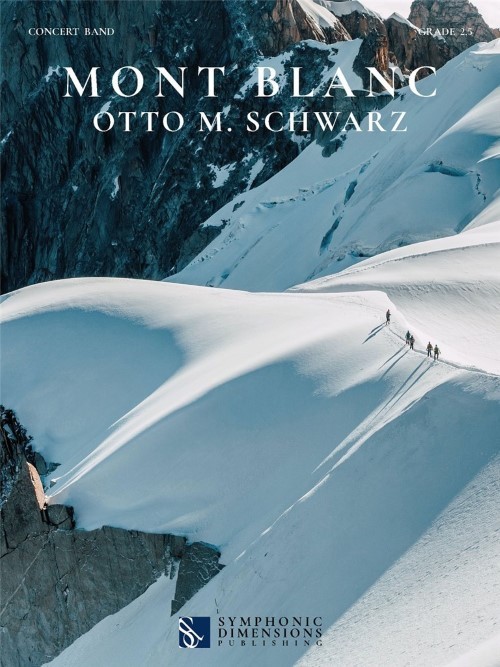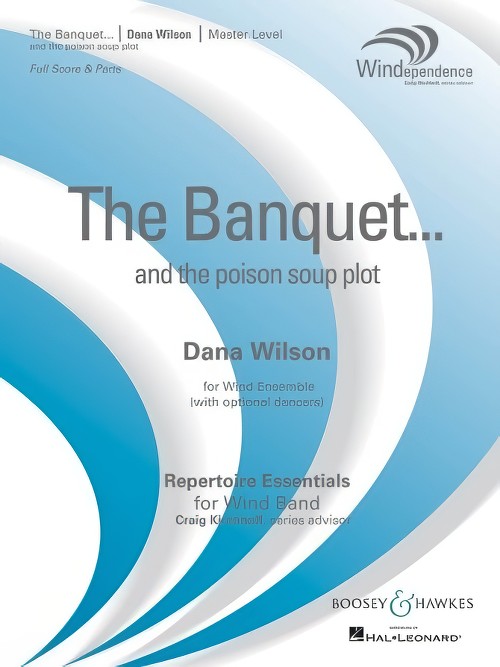Results
-
£49.50
Dr. Rock - Ralph Gingery
Just what the doctor ordered! Here's a really fun and easy to-play piece skillfully written for young bands. But be careful, they may not want to play anything else!
Estimated dispatch 7-14 working days
-
 £121.00
£121.00Ignatian Fanfare - John R. Bourgeois
Written for the centennial of Loyola University, New Orleans and premiered by the Loyola University Band on April 12, 2012 with the composer conducting. This fanfare is based on a motive from the Jesuit motto "Ad Majorem Dei Gloriam" ("to the greater glory of God") and is based on the notes A, D, G. The fanfare opens with timpani, a tintinnabulum of bells and brass, and wolf calls in the horns. A martial hymn tune appears which evokes the soldierly order of Ignatius Loyolas early years. The work closes with a rhythmic ostinato based on the words "Fight, fight, fight, ye men of the South!" The composer is a graduate of Loyola and received an honorary Doctor of Music degree in 2005.
Estimated dispatch 7-14 working days
-
 £168.50
£168.50The Bones of Mr. Fortune - Adolphus Hailstork
THE BONES OF MR. FORTUNE (FREE AT LAST!) is an 11-minute concerto-like work for solo flute accompanied by symphonic winds and percussion - perfect to play with band or with orchestra, as well as with the composer's own piano reduction (114-42424). The work features lengthy cadenzas, and exhilarating dance-like sections with the ensemble. Hailstork describes the historical inspiration: abused in life and death, an enslaved man (Mr. Fortune) was owned by a surgeon who preserved his skeleton to study anatomy. The bones remained with the doctor's family for generations, and were given a proper burial that made national news in 2013, 215 years after Mr. Fortune's death.
Estimated dispatch 7-14 working days
-
 £174.99
£174.99Two Symphonic Interludes - Harrie Janssen
Based on the poems by German poet Carl Hauptmann (late Romanticism) and the English poet William Wordsworth (early Romanticism). Carl Hauptmann was in poor health as a child, but highly intelligent. He studied philosophy, psychology and biology. In the latter he was admitted to the degree of doctor. His marriage provided financial independence, so that he could focus on his studies. Hauptmann wrote various novels, plays, poetry and scientific works. Night Twilight floats above the valley's night mists are hanging, there's a whispering brook. Now the covering veil is lifting quite: come and look! See the magicland before our gaze: tall as dreams the silver mountains stand, crossed by silent silver paths shining from a secret land. Noble, pure, the dreaming country sleeps. By the path the shadow black and hogh of a beach. a wisp of a white smoke creeps to the dark'ning sky. Where the valley is the darkest hued countless little lights shine silently. O my soul! Drink of solitude! Carl Hauptmann Wordsworth 'introduced' a new type of poetry, based on the speech of the common man. This was his answer to the poetry of the classicism which was bound by rigid rules. His definition of poetry was: the spontaneous overflow of powerful feelings from emotions recollected in tranquility. My heart leaps up when I behold a rainbow in the sky My heart leaps up when I behold A rainbow in the sky: So was it when my life began. So is it now I am a man. So be it when I shall grow old, Or let me die! The Child is father of the Man. And I could wish my days to be Bound each to each by natural piety. William Wordsworth In a truly poetic manner Harrie Janssen has transformed the contemplative thoughts of the poets into two compositions for Concert Band.
Estimated dispatch 7-14 working days
-
 £80.99
£80.99A Lasting Legacy - Swearingen
Dr. Martha Smith Geib was a life-long resident of London, Ohio where she routinely applied the practice of medical care and attention to those individuals in need of wellness. Upon her passing, the entire community was deeply saddened, not only for the loss of their doctor, but of their friend as well. It should be noted that this piece was written as a celebration of life for a remarkable lady who meant so much to so many.
Estimated dispatch 7-14 working days
-
 £123.20
£123.203 Letzte Motetten (Concert Band - Score and Parts) - Bruckner, Anton - Doss, Thomas
Anton Bruckner (b. 4.9.1824, Ansfelden, d. 11.10.1896, Vienna) didn't have it easy. Throughout his life, the Austrian composer was plagued by self-doubt. Anton Bruckner came from a simple, rural background. After the death of his father, he was accepted as a choirboy at the monastery of Sankt Florian in 1837. After several years as a school assistant and his own organ and piano studies, he first worked as organist in St. Florian, then from 1855 as cathedral organist in Linz. Introduced to music theory and instrumentation by Simon Sechter and Otto Kitzler, he discovered Richard Wagner as an artistic role model, whom he admired throughout his life and also visited several times in Bayreuth. In 1868 Anton Bruckner became professor of basso continuo, counterpoint and organ at the Vienna Conservatory; ten years later court organist; and in 1891 finally honorary doctor of the University of Vienna. He was considered an important organ virtuoso of his era, but had to wait a long time for recognition as a composer. It was not until Symphony No.7 in E major, composed between 1881 and 1883, with the famous Adagio written under the effects of Wagner's death, that he achieved the recognition he had hoped for, even if he was reluctant to accept it given his inclination towards scepticism and self-criticism. Anton Bruckner was a loner who did not want to follow a particular school or doctrine. He composed numerous sacred vocal works, such as his three masses, the Missa Solemnis in B flat minor (1854), the Te Deum (1881-84) and numerous motets. As a symphonic composer, he wrote a total of nine symphonies and many symphonic studies from 1863 onwards, tending to revise completed versions several times over. Bruckner's orchestral works were long considered unplayable, but in fact were merely exceptionally bold for the tonal language of their time, uniting traditions from Beethoven through Wagner to folk music, on the threshold between late Romanticism and Modernism. Anton Bruckner composed about 40 motets during his lifetime, the earliest a setting of Pange lingua around 1835, and the last, Vexilla regis, in 1892. Thomas Doss has compiled some of these motets in this volume for symphonic wind orchestra. These motets show many characteristics of personal expression, especially Bruckner's colourful harmony in the earlier works, which is in places aligned with Franz Schubert (changes between major and minor; and movements in thirds). Later works are characterised by many components which, in addition to the expanded stature of the movements, include above all a sense of the instrumentation as an outward phenomenon and the harmony as a compositional feature that works more internally. Some aspects of Bruckner's work are the result of his long period of study, which familiarised him not only with the tradition of his craft, but also gave him insights into the "modernity" of his time in such composers as Wagner, Liszt and Berlioz. From this developed his personal standpoint, which always pursues the connection between the old and the new.Duration: 14.00
Estimated dispatch 7-14 working days
-
 £95.99
£95.995 Tantum Ergo (Concert Band - Score and Parts) - Bruckner, Anton - Doss, Thomas
Anton Bruckner (b. 4.9.1824, Ansfelden, d. 11.10.1896, Vienna) didn't have it easy. Throughout his life, the Austrian composer was plagued by self-doubt. Anton Bruckner came from a simple, rural background. After the death of his father, he was accepted as a choirboy at the monastery of Sankt Florian in 1837. After several years as a school assistant and his own organ and piano studies, he first worked as organist in St. Florian, then from 1855 as cathedral organist in Linz. Introduced to music theory and instrumentation by Simon Sechter and Otto Kitzler, he discovered Richard Wagner as an artistic role model, whom he admired throughout his life and also visited several times in Bayreuth. In 1868 Anton Bruckner became professor of basso continuo, counterpoint and organ at the Vienna Conservatory; ten years later court organist; and in 1891 finally honorary doctor of the University of Vienna. He was considered an important organ virtuoso of his era, but had to wait a long time for recognition as a composer. It was not until Symphony No.7 in E major, composed between 1881 and 1883, with the famous Adagio written under the effects of Wagner's death, that he achieved the recognition he had hoped for, even if he was reluctant to accept it given his inclination towards scepticism and self-criticism. Anton Bruckner was a loner who did not want to follow a particular school or doctrine. He composed numerous sacred vocal works, such as his three masses, the Missa Solemnis in B flat minor (1854), the Te Deum (1881-84) and numerous motets. As a symphonic composer, he wrote a total of nine symphonies and many symphonic studies from 1863 onwards, tending to revise completed versions several times over. Bruckner's orchestral works were long considered unplayable, but in fact were merely exceptionally bold for the tonal language of their time, uniting traditions from Beethoven through Wagner to folk music, on the threshold between late Romanticism and Modernism. Hymns for four-part mixed choir a cappella (1846, St. Florian) No. 1 in E flat major (WAB 41/3): Quite Slow No. 2 in C major (WAB 41/4): Andante No. 3 in B flat major (WAB 41/1): Slow No. 4 in A flat major (WAB 41/2): Slow Hymn for five-part (SSATB) mixed choir and organ No. 5 in D major: Solemnly They are simple works, completely subordinate to their liturgical use, which nevertheless already show numerous characteristics of personal expression. These small pieces were able to stand up to the harsh scrutiny of the mature master: in 1888, Bruckner subjected them to a revision in which he made only minor corrections.Duration: 11.00
Estimated dispatch 7-14 working days
-
 £256.00
£256.0014 Motetten (Concert Band - Score and Parts) - Bruckner, Anton - Doss, Thomas
Anton Bruckner (b. 4.9.1824, Ansfelden, d. 11.10.1896, Vienna) didn't have it easy. Throughout his life, the Austrian composer was plagued by self-doubt. Anton Bruckner came from a simple, rural background. After the death of his father, he was accepted as a choirboy at the monastery of Sankt Florian in 1837. After several years as a school assistant and his own organ and piano studies, he first worked as organist in St. Florian, then from 1855 as cathedral organist in Linz. Introduced to music theory and instrumentation by Simon Sechter and Otto Kitzler, he discovered Richard Wagner as an artistic role model, whom he admired throughout his life and also visited several times in Bayreuth. In 1868 Anton Bruckner became professor of basso continuo, counterpoint and organ at the Vienna Conservatory; ten years later court organist; and in 1891 finally honorary doctor of the University of Vienna. He was considered an important organ virtuoso of his era, but had to wait a long time for recognition as a composer. It was not until Symphony No.7 in E major, composed between 1881 and 1883, with the famous Adagio written under the effects of Wagner's death, that he achieved the recognition he had hoped for, even if he was reluctant to accept it given his inclination towards scepticism and self-criticism. Anton Bruckner was a loner who did not want to follow a particular school or doctrine. He composed numerous sacred vocal works, such as his three masses, the Missa Solemnis in B flat minor (1854), the Te Deum (1881-84) and numerous motets. As a symphonic composer, he wrote a total of nine symphonies and many symphonic studies from 1863 onwards, tending to revise completed versions several times over. Bruckner's orchestral works were long considered unplayable, but in fact were merely exceptionally bold for the tonal language of their time, uniting traditions from Beethoven through Wagner to folk music, on the threshold between late Romanticism and Modernism. Anton Bruckner composed about 40 motets during his lifetime, the earliest a setting of Pange lingua around 1835, and the last, Vexilla regis, in 1892. Thomas Doss has compiled some of these motets in this volume for symphonic wind orchestra. These motets show many characteristics of personal expression, especially Bruckner's colourful harmony in the earlier works, which is in places aligned with Franz Schubert (changes between major and minor; and movements in thirds). Later works are characterised by many components which, in addition to the expanded stature of the movements, include above all a sense of the instrumentation as an outward phenomenon and the harmony as a compositional feature that works more internally. Some aspects of Bruckner's work are the result of his long period of study, which familiarised him not only with the tradition of his craft, but also gave him insights into the modernity of his time in such composers as Wagner, Liszt and Berlioz. From this developed his personal standpoint, which always pursues the connection between the old and the new.Duration: 39.00
Estimated dispatch 7-14 working days
-
 £78.50
£78.50Mont Blanc (Concert Band - Score and Parts) - Schwarz, Otto M.
With its height of 4,808 meters, Mont-Blanc is called the roof of Europe. The highest mountains on our planet have been insurmountable for a long time. Only in the past 250 years have those giants been mounted. Crystal-hunter Jacques Balmat and Michel-Gabriel Paccard, a doctor, were the first to climb Mont-Blanc, in 1786. Many paths lead to Mont-Blanc's peak: the regular ascent goes through the magnificent voie royale of Saint-Gervais-les- Bains, which was opened in August 1855 by the Englishmen Hudson, Kennedy, and Smythe. Today's most common route to climb up, starting from Saint-Gervais via Aiguille du Gouter (3,863m), Dome du Gouter (4,304m), and Arete des Bosses (4,547m), was first used in 1861. Otto M. Schwarz composed this work inspired by the roof of Europe with its luminous and huge glaciers. Early in the morning, mountain-climbers set off to the peak; they witness the sunrise, and experience the hazards that the journey up to the summit brings along. A snowstorm and falling rocks at Arete des Bosses aggravate their journey. A sudden change of weather, however, enables them to reach the top after a strenuous ascent. This piece invites you to an imaginary journey from Saint-Gervais-les-Bains via the voie royale to the top of Mont-Blanc.Duration: 6.45
Estimated dispatch 7-14 working days
-
 £85.00
£85.00The Banqet... and the Poison Soup Plot (Concert Band - Score and Parts) - Wilson, Dana
Providing a unique concert experience, this programmatic work depicts the story of what newspapers in 1916 described as "the poison soup plot"! At a Chicago banquet for dignitaries and politicians, a mass murder plot involving poison soup was hatched and nearly successful. However, thanks to a large number of unexpected guests, the dilution of the soup to feed everyone, and a quick thinking doctor with an antidote, tragedy was averted with no loss of life. Musical cues follow the events, and detailed program notes are included with the suggestion of including dancers to help tell the story. Imaginative and entertaining! Duration: 7.45
Estimated dispatch 7-14 working days
